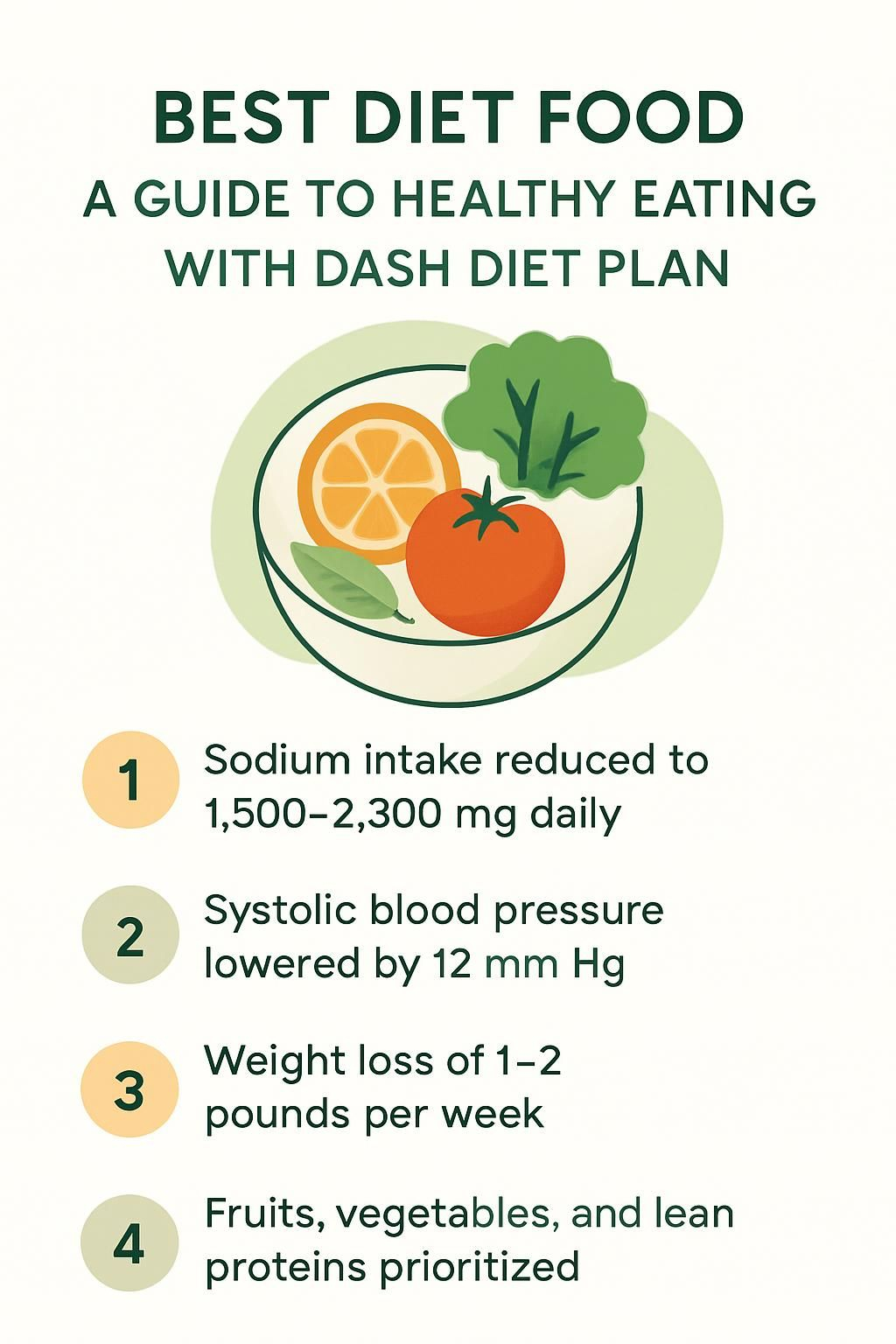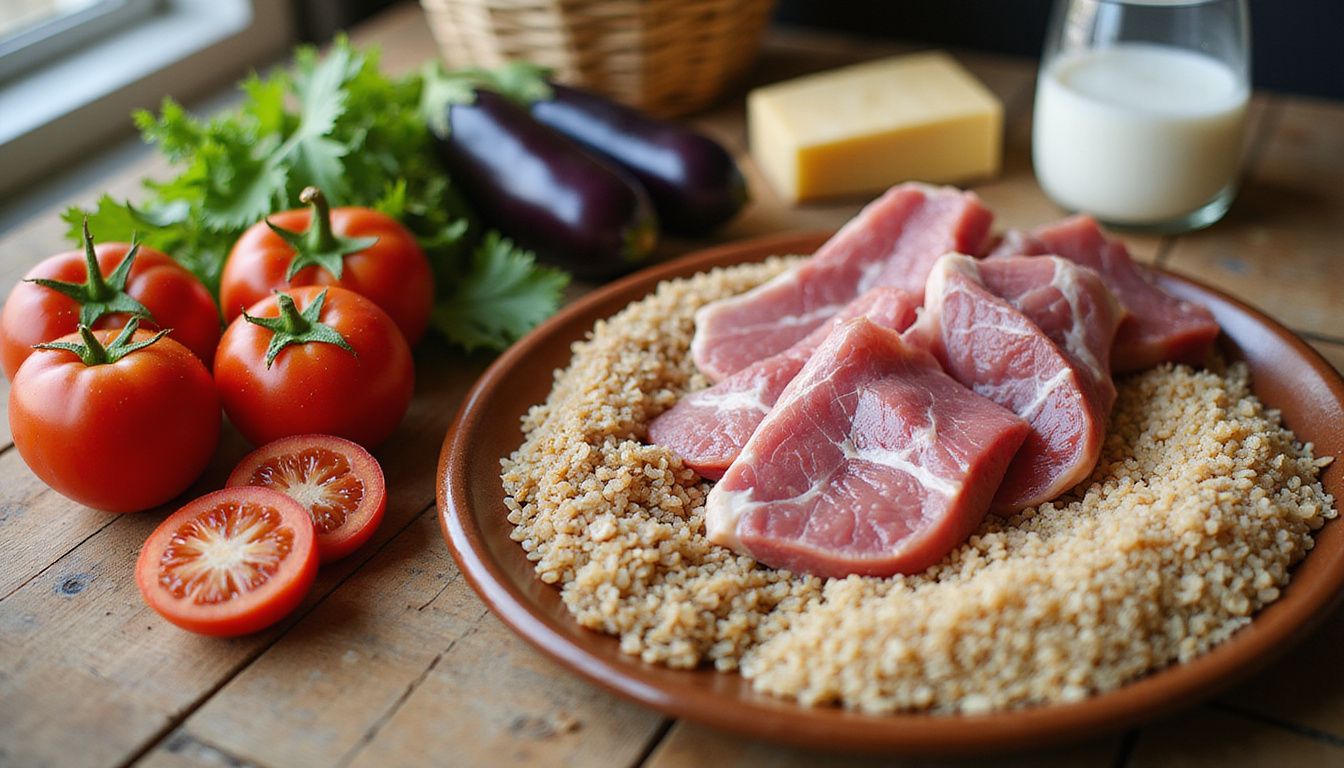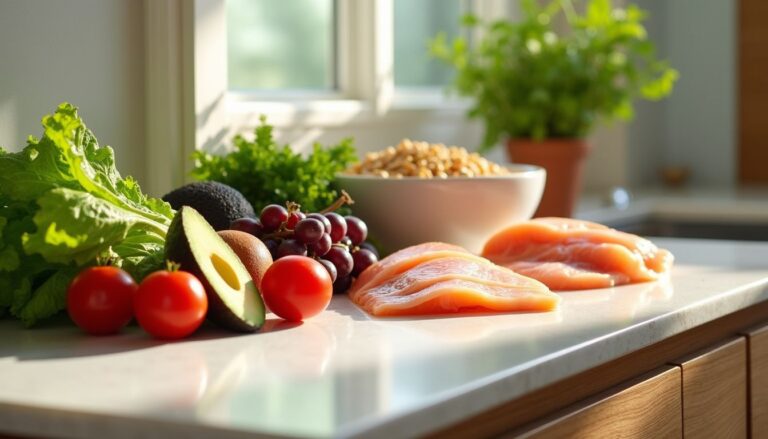Best Diet Food: A Guide To Healthy Eating With DASH Diet Plan
Our Nutrition Assistant AI Suite will transform your body. You will lose fat, get toned, and build muscle. Gain confidence and optimal health.
Finding diet food that truly supports healthy eating and steady weight management can be hard. It feels even tougher if you live with high blood pressure or worry about heart disease. The DASH diet gives a clear path, with simple foods you can find in any store.
Research from the United States Department of Agriculture shows a balanced diet lowers risk for chronic disease. The DASH eating plan highlights vegetables, whole grains, lean proteins, and low-fat dairy foods. It uses everyday food groups instead of special products, which keeps it practical and affordable.
This guide turns the science into steps you can use right away. I share tips I have tried, plus findings from trusted nutrition experts. Small changes add up. Over weeks and months, you can feel real health gains.
Key Takeaways
- The DASH diet, developed in the 1990s with National Institutes of Health support, lowers blood pressure by limiting sodium to about 1,500 to 2,300 mg per day.
- Clinical trials report systolic blood pressure drops of up to 7 to 12 mm Hg, with large studies showing sizable reductions in heart disease risk, including nearly 40 percent for men.
- The plan centers on fruits, vegetables, whole grains, lean proteins like fish or skinless poultry, low-fat dairy products, and nuts. It limits processed foods that are high in salt.
- Replacing red meat with lean protein sources, and skipping sugary drinks, supports weight control. A safe pace is about one to two pounds lost per week.
- USDA resources and Nutrition.gov highlight DASH because it uses familiar food groups, follows evidence, and helps people meet daily nutrition goals.

What is the DASH Diet Plan?

The DASH Diet Plan means Dietary Approaches to Stop Hypertension. It is a heart-healthy eating plan built around common food groups. The focus is balance, steady weight, and better cholesterol levels through everyday meals.
What is the DASH Diet and how does it work?
The DASH diet raises fruits, vegetables, whole grains, and lean proteins like fish and poultry. It cuts back on sodium, while boosting potassium, calcium, magnesium, and dietary fiber. These nutrients help control blood pressure and support heart health.
Cutting sodium from the average 3,400 milligrams per day to about 1,500 to 2,300 milligrams reduces cardiovascular risk. I swapped white bread for oats and brown rice. My meals felt fresher, and I stayed full longer.
NIH-funded studies in the late 1990s showed strong benefits, and the approach was first published in 1997. DASH does not rely on special foods. It uses food groups you know, including low-fat dairy like cottage cheese, legumes like lentils and beans, plus nuts and seeds that provide healthy fats.
I also learned to season with herbs and spices instead of salt. My soups kept their flavor, yet my blood pressure stayed within target.
Switching to heart-healthy eating can be simple if you learn new ways to season your meals.
Why is the DASH Diet so popular?
Once I understood how DASH works, its popularity made sense. Nutrition.gov and the USDA share guidance on this plan because the science is strong. People can adapt it to many cooking styles, like grilling or sautéing with vegetable oil instead of butter.
Studies report steady blood pressure improvements. Many show a 7 to 12 mm Hg drop in systolic numbers. Clear guidance from dietitians helps people trust the plan. I enjoy foods from different cultures while cutting saturated fat.
Community classes and webinars help explain the evidence in plain language. That support shows why many choose DASH over fad diets. It blends daily nutrition targets with flexible meals, which makes it easier to keep going.
Key Principles of the DASH Diet
The DASH diet follows a few simple rules that protect the heart for life. I set daily and weekly nutrition goals, then build meals that hit those targets.
Why focus on low-sodium foods?
High-sodium foods raise blood pressure quickly. Processed meat, canned soups, and salty snacks are common sources. Eating too much salt raises the risk of hypertension and heart problems.
The American Heart Association notes that keeping sodium under 2,300 mg can lower the chance of heart attack or stroke. I started reading cereal labels and found excess salt hiding in brands I liked.
Choosing low-sodium foods gives your circulatory system a real advantage.
I shifted to leafy greens, plain potatoes, and low-fat or fat-free dairy. That cut hidden salt while keeping key minerals like potassium and calcium. Diets rich in these nutrients support a healthy body weight and reduce the risk of heart attack.
How do fruits and vegetables fit into the DASH Diet?
Fruits and vegetables fill most of my plate on DASH. The plan encourages generous servings from these groups. Fries and heavily salted potatoes do not count toward the goal.
A 2019 review by Minich highlights the power of colorful plants. I snack on strawberries, peaches, blueberries, apples, and grapes. These foods are nutrient-dense, low in calories, and high in fiber.
Frozen or canned produce without added salt works well when fresh items are scarce. These choices deliver vitamins and minerals while helping control calories. They match U.S. guidance from MyPlate and support healthy eating patterns.
What role do whole grains play in the DASH Diet?
Whole grains sit at the center of my DASH plate. Oats, quinoa, barley, and brown rice provide fiber and steady energy. They help keep blood sugar stable across the day.
Research links higher whole grain intake to lower body weight and less inflammation. I feel fuller longer when I choose whole-wheat pasta or add quinoa to lunch salads. This keeps me from reaching for extra snacks.
Refined grains digest faster and can spike blood sugar. Whole grains digest slowly. That helps me manage calories without feeling hungry.
Why include lean proteins?
Lean proteins are another key pillar. Fish, skinless poultry, beans, nuts and seeds, eggs, and low-fat dairy bring protein with less saturated fat. That balance matters for the heart and for weight control.
Choosing lean cuts of meat or soybean-based foods helps me meet daily calorie needs without adding extra unhealthy fat. Swapping red meat for fish adds omega-3 fatty acids, which support heart health.
My weekly plan often includes grilled chicken with steamed vegetables. I also reach for yogurt with nuts as a snack. These simple choices offer variety without losing flavor or my health goals.
How to limit saturated fats and sugars effectively?
Keeping lean proteins high helps. Limiting saturated fats and sugars matters just as much. I trade creamy soups for broth or tomato-based versions to cut fat and calories.
I reduce full-fat dairy, butter, red meat, and processed snacks to avoid extra saturated fat. I drink water or unsweetened tea instead of sweetened beverages. I skip foods with trans fat by checking labels for hydrogenated oils.
For dessert, I choose fresh fruit or a small handful of nuts. These swaps reduce sugar and unhealthy fats while keeping meals satisfying.
Benefits of the DASH Diet
I noticed real changes as I followed DASH. The plan supports lower blood pressure and a healthier heart. It also makes daily meals feel balanced and practical.
How does the DASH Diet lower blood pressure?
DASH lowers blood pressure by reducing salty foods and prioritizing nutrient-rich choices. It emphasizes fruits and vegetables, whole grains, and low-fat or fat-free dairy products.
These foods add potassium, calcium, magnesium, and fiber, which support blood pressure control. Trials show systolic pressure reductions of up to 11 points in people with hypertension. USDA and Nutrition.gov recommend DASH because many adults improve without drastic changes.
I aim for servings from food groups instead of strict calorie counts. Lean meat, beans, nuts, and seeds provide protein. The plan limits saturated fat and added sugars and favors fresh ingredients over processed ones. The first research was published in 1997 with NIH support, and the evidence has held up since.
Can the DASH Diet reduce heart disease risk?
Lower blood pressure protects the heart, and DASH does more. Research shows eating patterns like DASH or the Healthy Eating Plate reduce heart disease risk by large margins. Some studies suggest reductions close to 40 percent for men and around 30 percent for women.
In a large study of post-menopausal women, a plan based on these principles lowered cardiovascular and heart failure risk more than a strict low-fat diet. Regular nut intake also supports better metabolic health. It helps reduce risk factors for long-term disease.
I include nuts for healthy fats and steady energy during workouts. This fits with whole grains, fruits, vegetables, legumes, and lean proteins, while limiting salty processed foods.
How does the DASH Diet support healthy weight management?
DASH helps with healthy weight by leaning on fiber-rich foods and adequate protein. Whole grains, legumes, and fresh fruits keep me full longer. A 2022 study linked high-fiber foods to lower body fat, especially for people with type 2 diabetes.
I swap chips and candy for an apple or a mix of nuts and dried fruit. Protein from fish, lean meats, legumes, and dairy helps control hunger and supports fat loss. A safe pace is about one to two pounds per week.
In what ways does the DASH Diet improve nutrition?
Nutrient-dense foods help me meet my body’s needs. DASH urges more fruits, vegetables, whole grains, and lean proteins. This pattern raises potassium and magnesium intake while lowering sodium.
People following DASH often eat 4 to 5 servings of fruit and vegetables daily. Low-fat dairy and legumes supply complete nutrition without many extra calories or unhealthy fats. Lean meats trim saturated fat, which supports heart health.
The Healthy Eating Plate suggests healthy oils, like olive oil, and water instead of sugary drinks. These habits fit all stages of life, including pregnancy and older age.
Foods to Include in the DASH Diet
I like picking from DASH-approved foods because they help me feel my best. You can mix and match based on taste, budget, and schedule.
Which fresh fruits and vegetables are best?
Strawberries, peaches, blueberries, apples, and grapes provide vitamins and antioxidants. Leafy greens like kale, spinach, and collards offer fiber and minerals that support fullness.
Broccoli, cauliflower, and cabbage are low in calories and high in fiber. That helps me feel satisfied after meals. These plants also help steady blood sugar when I include them in snacks and lunches.
Aim for a mix of colors across the week. That keeps nutrients varied and limits added sodium or sugar.
What whole grains and legumes should you eat?
Oats, brown rice, and quinoa are my go-to whole grains. People who eat more whole grains tend to lose more weight than those who choose refined grains. Quinoa and oats also have resistant starch that may increase fullness.
Lentils, black beans, and kidney beans bring fiber and protein that help digestion and satiety. I also snack on chia seeds for fiber and plant omega-3s. Whole grains and legumes help steady energy through the day.
Why choose low-fat or fat-free dairy products?
Low-fat and fat-free dairy keeps saturated fat in check while delivering calcium and protein. Cottage cheese adds protein without much unhealthy fat. Greek yogurt provides protein and often includes probiotics for gut health.
Some full-fat dairy can help with fullness. Yet toppings like sugary granola can add many calories fast. I choose low-fat options most of the time for heart health and easier weight control.
What lean proteins are recommended?
Fish like salmon and trout provide protein, healthy fats, and iodine for thyroid function. Adults should aim for at least 8 ounces of seafood per week. Skinless chicken breast is another reliable choice with less saturated fat than many red meats.
Lean beef cuts, such as sirloin or tenderloin, can fit when cooked with care. Baking, roasting, grilling, or sautéing keeps extra calories low. Beans and lentils add plant-based protein and fiber for variety and budget-friendly meals.
Now that proteins are covered, I will touch on nuts, seeds, and healthy fats. These add flavor and help with fullness.
How do nuts, seeds, and healthy fats benefit you?
Nuts deliver unsaturated fats, protein, and fiber that support heart health. I keep portions to about 1 ounce per day. That helps lower the risk for chronic disease without adding too many calories.
Avocados supply healthy fats, fiber, water, and potassium. These nutrients can improve satiety and help absorb fat-soluble vitamins like A, D, E, and K. Since nuts and avocados are calorie-dense, I measure portions to stay on track.
Foods to Limit or Avoid
Some foods raise blood pressure and strain the heart. Knowing what to limit keeps DASH results strong.
What high-sodium processed foods should be avoided?
Frozen dinners, canned soups, deli meats, and snacks like chips are top sodium sources. Most sodium comes from processed items, not the salt shaker.
One instant noodle cup can top 1,000 mg of sodium. A single slice of frozen pizza may hit 700 mg or more. Even bread and cheese slices add up across the day.
My blood pressure improved after I cut these foods. I replaced boxed macaroni with roasted vegetables and chose no-salt-added beans. I also trimmed sodium from bottled dressings and sauces.
Why avoid sugary beverages and desserts?
Sugary drinks and desserts pack many calories with little nutrition. A can of soda often contains over 35 grams of sugar, about nine teaspoons. High sugar intake raises the risk for heart disease and weight gain.
I choose water, tea, or coffee with little or no sugar to fit DASH. That one switch helps control calories and supports long-term health.
What are the risks of eating red and fatty meats?
Red and fatty meats, including bacon and many cold cuts, raise the risk of heart disease and some cancers. Diets high in saturated fat can clog arteries and push up blood pressure.
DASH encourages lean proteins instead. That change supports metabolic health and protects the heart across time.
Why limit full-fat dairy products?
Full-fat dairy has more saturated fat, which can raise cholesterol. Higher cholesterol increases the risk of heart disease and hypertension. DASH favors low-fat or fat-free milk and yogurt.
One cup of whole milk has about 4.5 grams of saturated fat. Skim milk has almost none. I switched to low-fat yogurt as a daily habit. It was a small change with real benefits.
Which foods are high in trans and saturated fats?
Many baked goods, like cookies and pastries, contain trans fats. Some fried or processed foods, including chips and certain frozen items, also contain them. Butter, fattier red meats, and some dairy foods are high in saturated fat.
Trans fats raise unhealthy cholesterol. Saturated fats can increase heart disease risk. I replaced packaged snacks with simple homemade options and saw better cholesterol within three months.
Sample DASH Diet Meal Plan
A simple meal plan makes daily choices easier. I pick one idea from each section and rotate through the week.
What are some healthy breakfast ideas?
I start many mornings with eggs for protein and steady energy. People who eat an egg-based breakfast tend to stay full longer than those who choose sugary cereal.
Whole-grain picks like oatmeal or whole-wheat waffles support DASH fiber goals. I add sliced bananas or berries for vitamins and flavor. These meals use simple ingredients and keep sodium low.
What lunches fit the DASH Diet?
Clear vegetable soups make excellent lunches and help with weight control. Starting a meal with a broth-based soup can increase fullness and reduce total intake.
I like minestrone or lentil-tomato soup with a side salad. A balanced DASH lunch includes vegetables, a lean protein like grilled chicken or beans, and a whole grain such as brown rice or quinoa. That mix boosts nutrients while keeping sodium in check.
What dinner options are recommended?
I build dinners with lean protein, whole grains, and vegetables. Grilled salmon, roasted chicken breast, or baked white fish are reliable choices with less saturated fat.
I pair these with brown rice or quinoa for fiber. Baked potatoes or roasted root vegetables beat fried versions because they avoid extra oil. I cool boiled potatoes before serving to raise resistant starch, which may support weight management.
Steamed broccoli or a fresh spinach salad adds potassium and vitamins. That balance keeps the meal satisfying without heavy sauces.
What are good healthy snack choices?
After a balanced dinner, I pick smart snacks to keep energy steady. Greek yogurt with chia seeds brings protein, fiber, and plant omega-3s and supports fullness.
Apples and carrot sticks offer crunch and fiber with few calories. Nuts and seeds work well if I keep them to a 1-ounce portion. Swapping chips for these options fits DASH and reduces cravings.
Tips for Starting the DASH Diet
Starting DASH gets easier with a few simple habits. Small daily steps build momentum and stick over time.
How to gradually reduce sodium intake?
I replace table salt with basil, oregano, garlic powder, and citrus. Gradual sodium reduction trains the palate while supporting blood pressure control.
- Target less than 2,300 mg sodium per day, with 1,500 mg as the ideal goal.
- Cook more from scratch with fresh vegetables and lean proteins.
- Rinse canned beans and vegetables to remove extra salt.
Reading labels helps me spot hidden sodium fast. After a few weeks, food tastes just as good without the extra salt.
How to read nutrition labels effectively?
Label reading became my daily skill. I check serving size first because all numbers on the label reflect that amount. If a bag lists two servings and I eat it all, I double every value.
I also watch sodium closely. DASH suggests less than 2,300 mg per day, ideally about 1,500 mg. Many canned soups contain more than 700 mg per serving. I review total fat and added sugars before I put anything in the cart.
What are the best meal prepping and planning tips?
Meal prep keeps me consistent and helps with portions. I follow the Healthy Eating Plate during shopping, choosing vegetables, whole grains, and lean proteins that match DASH.
I cook in batches for three to five days and store meals in labeled containers. A food log or planner helps me track progress and spot which meals work best. Prepped snacks, like cut fruit and unsalted nuts, make healthy choices fast on busy days.
How much water should you drink daily?
Water is my main drink. The Healthy Eating Plate echoes this guidance. DASH encourages limiting milk and juice to one small glass a day.
I aim for about eight 8-ounce glasses of water daily, the 8×8 guideline. That is around two liters. Staying hydrated supports digestion and helps manage cravings.
Common Questions About the DASH Diet
Here are clear answers to questions I hear often. They can help you decide how to start and what to change first.
Can you follow the DASH Diet as a vegetarian?
Yes. I focus on plant proteins like beans, legumes, nuts, and seeds. I fill half my plate with leafy greens and seasonal vegetables for variety and nutrients. Low-fat dairy fits if I am not fully vegan.
Recent reviews show vegetarian versions of DASH still reduce blood pressure1. MyPlate principles work across cultures and preferences. Whole grains, like brown rice and quinoa, also play a key role in vegetarian DASH patterns.
1 Joffres MR et al., “Dietary Approaches to Stop Hypertension (DASH) Vegetarian Diets Improve Blood Pressure Control: A Meta-Analysis,” Journal of Nutrition Science, 2023.
Is the DASH Diet good for weight loss?
DASH supports weight management because it prioritizes high-fiber, higher-protein foods that promote fullness. Research shows people on DASH tend to lose more weight than those on a standard American diet.
Results vary since individual calorie needs differ. The plan reduces added sugars and saturated fats, which improves eating patterns. Talk with a healthcare professional before major changes, especially if you have medical conditions or take medications.
How does the DASH Diet compare to the Mediterranean Diet?
Both DASH and the Mediterranean Diet highlight whole grains, fruits, vegetables, lean proteins, and healthy fats like olive oil and nuts. Both reduce red meat and processed foods and support heart health.
DASH places stronger focus on sodium reduction. The Mediterranean style uses more olive oil and sometimes includes moderate wine, while alcohol is not a feature of DASH. I use Healthy Eating Plate ideas to blend the strengths of both when planning meals.
What are the recommended daily servings?
DASH focuses on balance rather than strict calorie limits. I make half my plate fruits and vegetables. I choose many colors to cover vitamins and minerals.
Whole grains take about one-quarter of my plate. Lean proteins, like chicken or beans, take the last quarter. Nuts and seeds fit at about 1 ounce per day. Low-fat or fat-free dairy appears in moderate amounts. Healthy oils are used sparingly for cooking or dressings.
Conclusion
The DASH diet helps me center meals on fruits, vegetables, lean proteins, and whole grains. Strong research links this pattern to lower blood pressure and better heart health. It also supports steady weight control without extreme rules.
Start with small changes, like adding one vegetable serving at lunch and choosing low-sodium options. If you have a health condition, talk with your clinician or a registered dietitian first. This article is for education, not medical advice. With steady steps, you can build a balanced diet that lasts and feels good day after day.
FAQs
1. What is the DASH Diet Plan and how does it support healthy eating?
The Dietary Approaches to Stop Hypertension (DASH) Diet Plan focuses on fruits, vegetables, whole grains, lean proteins such as poultry or fish, and low-fat dairy products. Research from the National Institutes of Health shows this plan lowers blood pressure and supports heart health by reducing sodium intake while increasing nutrients like potassium, calcium, and magnesium.
2. Which foods are recommended in a DASH Diet for best results?
Key foods include leafy greens such as spinach or kale; berries; brown rice; skinless chicken breast; beans; nuts like almonds or walnuts; fat-free milk or yogurt. These choices provide fiber, vitamins, minerals, and protein with less saturated fat.
3. How effective is the DASH Diet compared to other diet plans?
Clinical studies show that people following the DASH Diet often see lower systolic blood pressure within two weeks compared to those on typical American diets. The plan also helps reduce LDL cholesterol levels according to data published in peer-reviewed journals.
4. Can you share a personal experience using the DASH Diet Plan?
After switching breakfast from pastries to oatmeal topped with blueberries and walnuts plus choosing grilled salmon salads for lunch instead of fast food burgers I noticed improved energy levels within days. My doctor confirmed my blood pressure dropped after three months which matched findings reported in medical research articles.
Summary: The DASH Diet emphasizes nutrient-rich foods proven by scientific evidence to improve heart health lower blood pressure and offer lasting benefits when followed consistently.







